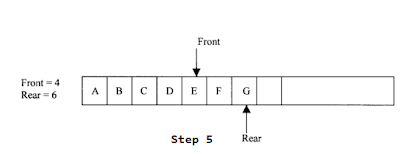Breadth First Search (BFS)
Many
application of graph requires a structure based system to determine the
vertices and
edges of a graph G. That is called a graph traversal, which
means visiting all the nodes of the graph. There are two graph
traversal methods
-a) Breadth First Search (BFS)
-b) Depth First Search (DFS)
Today i will
discuss about Breadth First Search. Given
an input graph G = (V, E) and a source vertex S, from where the searching begins. The Breadth first search(BFS) systematically traverse the edges of G to explore every vertex
that is reachable from the source vertex S. Then we examine all the vertices neighbour to source
vertex S. Then we traverse all the neighbours of the neighbours of source vertex S
and so on. A queue is used to keep track of the
progress of traversing the neighbour nodes.
Now,I will discuss Breadth First Search with an example.Because
it will be more easier approach to understand BFS. Consider the following graph in Fig 1 and it’s corresponding adjacency list (Fig 2).
Suppose the source vertex is A . Then following steps will illustrate the Breadth First Search (BFS).
Step 1: Initially we push A (the given source vertex) to the queue.
Step 2: Pop (remove) the front element A from the queue (by incrementing front =front +1) and display it. Then push (add) the neighbouring vertices of A to the queue, (by incrementing Rear = Rear +1) if it is not in queue.
Step 3: Pop the front element B from the queue and display it. Then add the
neighbouring vertices of B to the queue, if it is not in queue.
One of the neighbouring element C of B is present in the queue, So C is not added to queue.
Step 4: Remove (pop) the front element C and display it. Add the neighbouring vertices of C,if it is not present in queue.
One of the neighbouring elements E of C is present in the queue. So E is not added.
Step 5: Remove the front element D, and add the neighbouring vertex if it is not present in queue.
Step 6 : Again repeat the process (until Front > Rear).That is remove the front element E of the queue and add it to the neighbouring vertex if it is not present in the queue.
So A, B, C, D, E, F, G, H is the Breadth First Search(BFS) traversal of the given graph in Fig. 1. I hope now you have understood the BFS traversal method. So now have a look on the formal BFS algorithm given below :
ALGORITHM
1. Input the vertices of the graph and its edges G = (V, E)
2. Input the source vertex and assign it to the variable S.
3. Add or push the source vertex to the queue.
4. Repeat the steps 5 and 6 until the queue is empty (i.e., front > rear)
5. Pop the front element of the queue and display it as visited.
6. Push the vertices, which is neighbor to just, popped element, if it is not in the queue and displayed (i.e., not visited).
7. Exit.
------------------------------------------------------------------------------------------------------------
REGARDS
Shankha Jana















this is nice blog. Contents over here are so informative. For more on these topics, visit here.. Breadth First Search (BFS) and Depth First Search (DFS)
ReplyDelete